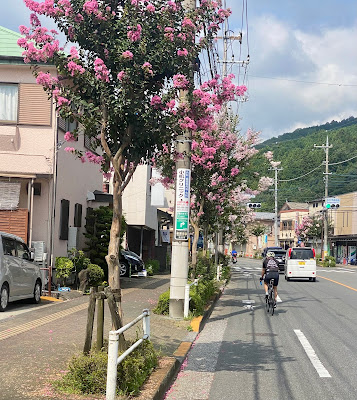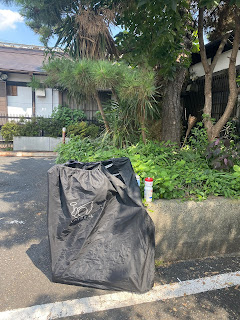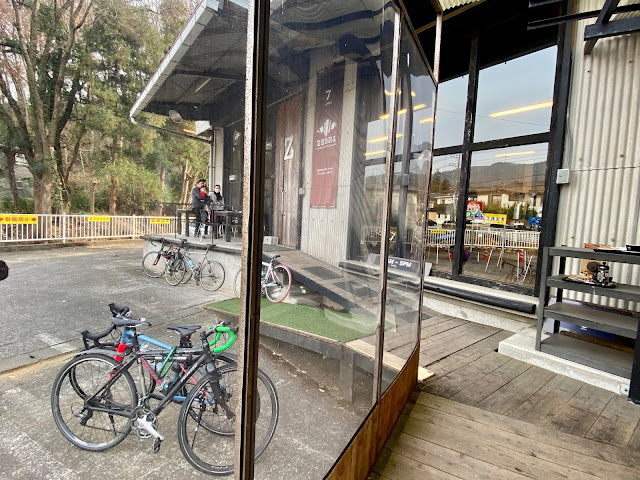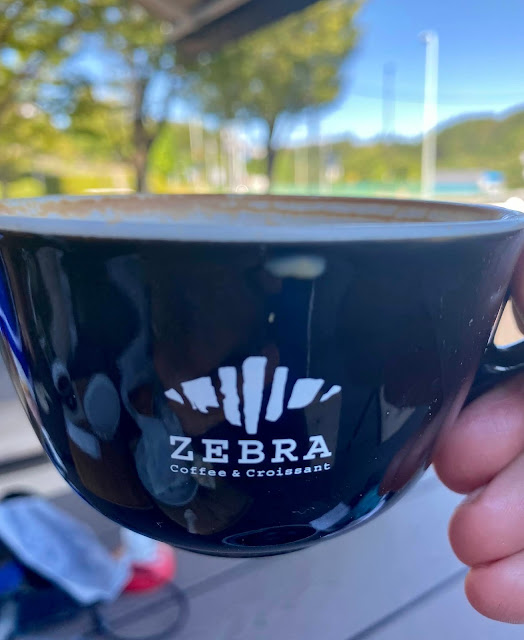In late April, I got my first new bicycle in six years.
And it is (drumroll … ) a “Pelso Brevet” carbon frame high racer recumbent!
 |
| Pelso Brevet - along the Tamagawa near Tachikawa |
 |
| Pelso brevet - near Kawasaki |
 |
Recumbent bike leaning ... at Haneda.
That rear seat bag is great - holds a lot of gear and smooths air a bit around the back of the bicycle. By Radical Designs of the Netherlands. |
 |
More bike leaning ... further afield.
Note the handlebar stem angle--reversed so that I would have more shin clearance. |
 |
| Me riding the Pelso, passing Komae along the Tamagawa. |
 |
| Pelso advertisement -- thin, strong young helmetless riders on the bike in an Alpine setting! |
No, it is actually not my first recumbent. Nearly 20 years ago, I also bought a recumbent, on sale as a deep, deep close-out at a local Trek dealer in the Maryland suburbs of Washington DC. It was the only recumbent Trek ever made (and the only Trek I have ever bought), the R-200, and was discounted because Trek had discontinued the model. Trek dealers did not know anything about recumbents, and could not sell them. Worse, apparently Trek dumped their factory inventory to a liquidator for next to nothing, and he was selling the bikes online, so the dealers were forced to dump their inventory as well. The technology of a recumbent fascinated me, however, and I thought it would be a good experiment. I had read that recumbents were so fast they had been banned by the UCI in the early 1930s, as soon as a relatively average rider on a recumbent broke the “hour record” set by a storied professional rider on an upright, diamond frame (“DF”) bike.
But the R-200 was not going to break any hour records! It was a short wheelbase model, but very heavy, and not so easy to get accustomed to riding. It had small (20”?) wheels with heavy rims and tires, and I could never get it to go any faster on the flats than my road bike. It was slow as molasses climbing hills. I never liked the mesh seat, which started to fray at some point after getting a small tear.
Here is some explanation at an online shop (in the "brands we don't stock" category).
When I moved to Japan, I gave the R-200 to a friend (who is a Trek fan, at least). He had a big basement with room for storing bikes, after his garage wall racks had filled up.
I don’t think I even realized at the time that recumbents are, well, looked down up, literally and figuratively, by some roadies, especially roadies who follow “The Rules”. The U.S. recumbent industry is dominated by somewhat older, heavier, bearded, sloppy looking types, not like those Pelso model riders. Here are some shots from a Youtube video covering the (virtual version of the) industry trade show last year.
And yes, it seems that trikes take up an ever larger share of the U.S. recumbent market ... So despite Cruzbikes and Bacchettas winning RAAM, "recumbents" in the US are targeted at an older, weaker, segment of the market.
Fortunately, cycling culture has become more diverse and welcoming in the past couple decades, with fatter tires, gravel bikes, e-bikes, bike packing setups, audax, and other streams that compete for attention among trend-followers with traditional road cycling and now get a bit of respect.
Recumbents are to DF’s as violas are to violins!
Any “full size” violin is the same size, and the same shape, as any other. Stradivarius got the formula right, and every violin maker since follows it. There are no “UCI rules” for violins, but there might as well be. How to you make a good violin? Get as close as possible to a Strad.
Violas, on the other hand, come in all shapes and sizes, from <37cm long to >44 cms or even longer. There are “cut out” versions like the ones made by Otto Erdesz (a violist collague and friend of my mom, had an Erdesz viola … but not one of his cutouts). And there is the “Tertis” shape, named after famous violist Lionel Tertis, for whom many great works were written early in the 20th century. He designed and played an instrument with a much wider body, a kind of “big butt” version of the viola, that allows a deeper, more cello-like tone without making the body of the instrument so long that it becomes unwieldy or impossible to play for a smaller person with shorter arms. You can still make a better viola by innovating. Oh, where was I? Recumbents, right? You can innovate with recumbents even more so!
 |
Recumbent innovation -- good.
Legendary bike designer Mike Burrows on a very fast machine. |
 |
| Recumbent bike innovation -- ugly. |
In British Columbia in 2012, I rode with Matthew O’Neill, who was on a Bacchetta “stick” recumbent for the Rocky Mountain 1200, having recently switched from a road bike. We rode together on part of the Icefields Parkway, and then later nearly all of the last 24 hours, including one section in a transcendent state accompanying complete exhaustion, cruising alongside Mera Lake between Sicamous and Armstrong on a warm, starry evening. The Bacchetta could climb reasonably well – at least Matthew made it up the big climb -- and it had 700c wheels.
I test-rode some recumbents (including a partly successful 30-minute attempt to learn how to steer and keep upright a Cruzbike) at Rose City Recumbents when back in Portland a couple times over the years.
At 2015 Paris-Brest-Paris, I started in the group just following the “special bikes”, and, off like a rabbit, quickly found myself among them. The recumbents made good time, and came in all shapes and sizes. There were short and long wheelbases, low and high racers, even recumbent tandems with the stoker in front leaning back with a great view, while the captain sits upright in the rear, steering. Racing trikes?! And, of course, there were fully faired velomobiles with an aerodynamic profile that allows them to reach speeds twice as fast as a normal bicycle on a flat course … but that struggled on hills late in the event.
In 2016, at the Okayama 1200 and Hokkaido 1200, one rider, Peter Heal, brought his recumbent from Australia. He finished many hours ahead of me in both events, especially the Hokkaido one. I learned that Peter holds the records for both the fastest unsupported, solo west-to-east crossing and coastal circumnavigation of the Australian continent by bicycle (on a Velokraft carbon recumbent with tailbox – rear fairing -- and rear disk wheel that is in the collection of the National Museum of Australia). The bike he rode in Hokkaido … was a self-designed and homemade carbon frame, divisible into two and with a front wheel drive, designed for ease of international shipping. Peter has built at least five recumbents of various different styles for his own use. Now that’s something!
So after a few failed attempts to complete 1200km events in recent years – I just did not want to finish badly enough to punich my body so brutally – I started to think about getting a recumbent. Does a recumbent offer a way to do an ultra-endurance ride with less stress on the body? Some believe that it does. The body’s position is more relaxed, with support all along your back, and even a headrest if you use a steeply reclined seat. Your arms are resting at your sides, no weight upon them. The leg muscles … get just as much of a workout as on a DF, or more. But the rest of the body, especially the hands, neck, and groin, should be much less stressed. On the other hand, could I actually climb hills well enough on a recumbent to do longer rides, especially in Japan?
I started exploring bikes. What is available? I thought about getting a Cruzbike. They offer a one-year money-back warranty, since it takes time and effort for many to learn how to ride them comfortably. … I asked a friend, who introduced someone else who has tried just about every type of recumbent. He said that a Cruzbike takes a lot of extra effort and attention, you cannot relax and let your mind wander. That sounded aa bit different than what I was looking for. One experienced rider said that the Lightning P-38 recumbent still offers the best combination of maneuverability in traffic, stopping, starting, and speed. From their website, it looked as if it would take some time to order a new one, the base components were not great for an already expensive bike, and upgrades would make it quite expensive. And a used P-38 … without the latest (carbon) fork or room for slightly wider tires … did not seem like a good idea, and would not be available for shipping to Japan. I did not like the idea of a small (20”) front wheel. That may be the secret to its maneuverability, but it means a very limited choice of tires and, I thought, perhaps a less stable, comfortable ride on the open road. And the stock seat looked like the mesh Rans one I remembered from the Trek R-200. I thought perhaps I might enjoy it, but I would need upgrades to do so. Maybe someday.
I saw that plenty of recumbent makers offer a “high” and a “low” racer version. The “low” version may be more aerodynamic and thus faster at the high-speed end, but I wanted the visibility to other cyclists and to drivers of being at a more normal height, so I was looking for something a far off the ground. These “high racers” have evolved a fair bit since the Bacchetta that Matthew rode in Canada. Optima Baron (high and low racers – now defunct), Velokraft (now defunct – out of California) are other fast longer wheel base designs. Also, M5 (Netherlands) and Performer (Taiwan), each with a range of models, and with the M5 range including plenty of seriously fast bikes.
I saw that Bacchetta acts as the U.S. distributor for a carbon framed “high racer” with 700c wheels called the Pelso Brevet, made in Hungary. John Schlitter, formerly of Rans, and the designer behind the (somewhat similar shape to Pelso) Schlitter Encore and Schlitter Freestyle, had a hand in its design.
The reviews I could find suggested that this would be a great “all around” recumbent. Reasonably fast, reasonably light, reasonably comfortable, a reasonably aerodynamic riding position, a decent spec of standard components, incorporating much of the learning of recent years in recumbent design. The frame has a “wavy” shape with two bends in the middle behind and in front of the seat, so that the seat is lower than on a “stick” recumbent, making it easy to put one’s feet down to stop and start.
Most important, as the global bike industry is still in a pandemic-induced shortage of just
about everything, Pelso’s website and online posts suggested that had received its full stock of 2021 carbon frames, they had components in stock, and the bike was available for immediate shipping from Hungary (with ca. 2019 SRAM GX 1x drive components.) I had no idea how long it would take me to get some of the other options, and I wanted to have the bike to ride this summer.
So I ordered the Pelso Brevet. I figured that, if I really enjoy it, then there will be plenty of chance to experiment. There can be a “next time” to get another recumbent after lots of test riding, discussion, and weighing of the pros and cons, the purpose, etc. Maybe one specifically for travel? Or for maximum speed? Or maybe I will find the longer wheel base to be enough of a pain in the butt to deal with that I will just consider it an experiment and never ride one again?
The Pelso arrived soon after the Okayama 1200, in a very big box. Once I unwrapped an awful lot of plastic wrap, I could do the final assembly, and after one or two “sessions” rolling along with my feet on the ground mostly—to figure out how to start and stop safely—I was soon going on short rides. My close-to-home routes headed south through Takanawa and Gotenyama and beyond … perhaps to Katsushima, or Heiwajima, or just across from Narita, then back north closer to the Bay, near Tennozu and Shibaura or beyond, then back to Takanawa. This became a kind of “loop commute” during work-from-home. I repeatedly adjusted the seat and the “J” handlebars over the first month, got a nice wide, flat pair of pedals (I tried SPD pedals/cleats but they did not make much difference in the recumbent position). I took some longer trips, including along the Tamagawa and the Arakawa, and even a few hills (the last thing to conquer). Within 6 weeks of setting it up, I had ridden nearly 1000 kms. Despite taking a number of recent rides (e.g. my Olympics recon rides) on the Parlee, I still have managed to get to nearly 2000kms on the Pelso, including a few 150km+ days.
I can confirm that, on the flats, the Pelso is indeed faster than a road bike. And it is a lot of fun to ride. If I can cruise at 2, 3, or perhaps 4 kph faster than on a road bike, without more effort, that could make a huge difference on a long ride. Going into the wind on a flat course, I can enjoy passing average recreational road cyclists as if they are standing still.
And, even on the longest rides I have done so far … near 200kms … my leg muscles, especially just above and below the knee, feel tired, but there is no back stiffness, no hand numbness, no saddle sores. I HAVE experienced some feet pain on a longer ride, as on the road bike, but with the Pelso I am not clipped in and can adjust my foot position, and lighten the foot pressure, to quickly relieve it.
On the other hand, its long wheelbase and steeply reclined seat mean that the Pelso is less maneuverable than a road bike going through narrow gaps or making sharp turns.
And because I am lower to the ground than on a road bike—though nowhere near as low as on a low racer recumbent or recumbent trike that hugs the ground—I am less visible when I come around a car or obstruction. I may attach a small flag rising at a diagonal from the seat, both for visibility and to warn cars and trucks not to pass too close, but I will need to drill a few (more) holes in the carbon seatback in order to do so.
The bike came with a 1x 42-tooth front cassette and an 11-42 11 spd rear cassette. On a road bike, that would be plenty, with “lighter” gearing than the lightest gears I have used (50/34 front and 11-32 back). Tim Smith of GS Astuto set me up with an 11-46 rear cassette, and I definitely need the 46 tooth cog for spinning up steeper hills with the body steeply reclined. Even going up a relatively easy climb such as the “Renkoji” climb north of Onekan, or the climb from Takao to Otarumi, I need relatively low gears, eventually the 42 teeth, and I climb probably 10%-15% slower than on the road bike. I think for really long climbs, I should adjust the seat angle so I am more upright. That should help … but I have yet to try it. So far I have climbed hills such as Renkoji (a few times), Otarumi Pass, Jerome Hill (Umegaya Pass), the Bonbori Rindo (walking part of the way, as I dismounted on some steep sections where the road was partially blocked and very narrow) … and would have to say, I am overweight and underpowered, but confident that eventually it will become easier (as it did with a road bike), and that I will be able to use the bike on a “normal” Japanese course, even if I will never select it for a “mountain” course or crazy steep climbs.
On my first rides over 100km, my neck muscles tired from the new experience of needing to hold my head upright while my body is so far reclined back. I added a small fiberglass headrest—drilling holes in the seatback—and now I can relax my neck muscles when I want. At this point, I doubt it is necessary for a one-day ride (the small headrest pad fell off recently on a very long ride, and I did not even notice until the next time I dismounted). But the headrest would be essential for a multi-day endurance event, and it gives me confidence to ride with a steeper recline, which ultimately, on a flat course should be faster.
My default move when I get to very slow speed, or a tricky turn, or when starting up from a traffic light, is to sit up while keeping my feet up on the pedals. Then at least I can quickly put both feet down if needed. So far, I have yet to lose balance (without putting a foot down) or fall over, and if I am lucky and careful, I hope to ride tens of thousands of kilometers without doing so.
With the body at a steep recline, I feel a bit as if I am lying on a beach in the sun as I ride. Sunscreen is essential, as the legs, arms, and face, are far more directly exposed to sun than riding a road bike position. I think the Pelso will be ideal for riding in cooler months of the year – along the Arakawa, Tamagawa, to/from Miura Peninsula, winter 200km brevets, and the like, and I will achieve faster speeds with more comfort than a road bike.
I have managed to “rinko” with the bike, wheels off and covered up, a couple times, … and have yet to be kicked off of a train. But it weighs 50% more than a road bike (12 kgs, before attachments) and is far bulkier (to the point where I am afraid it just bumps up against the limitations of JR permitted luggage.
So if recumbents are faster, and more comfortable, why do we not see more of them, other than the UCI rules? Well, the bulky size, relative lesser maneuverability and visibility, are disadvantages. But mostly, I think that road bikes have gotten … better and more comfortable in recent decades. I remember the first time I tested an aluminum frame cyclocross bike around 20 years ago – the frame was stiff to the point of painful after only a few minutes riding. Over time, focus as shifted to bikes that are all-day comfortable. Even aero frames are now designed to be comfortable. And tire sizes … we used to ride 700x23 with 110psi or more, or even 700x20. Now, the typical roadbike has 700x25 or 700x28 tires, and plenty use 700x30, 32, or even 650Bx42 or fatter. Rims are much wider, so even the same size tire holds more air than it once would have. Tire pressures are 60-80psi, instead of 100-120 – with plenty of support for the idea that, on many road surfaces and for many riders, theses fat, lower pressure tires go as fast as the thin, high pressure ones. Saddles are more ergonomic. The fatter tires at lower pressures, and modern frames and ergonomic saddles, reduce the punishment to the body from road cycling, a lot. So many of the cyclists who might have switched to a recumbent at some point, to solve a problem with back pain, numb hands, enlarged prostate, or whatever, … do not feel a need to do so.
I plan to continue to ride the Pelso when I can do so, to mix and match road bike and recumbent, for awhile. I love all my bikes, and I want to get competent using each in the circumstances most suited for it. Maybe I will even try for PBP 2023 ... or another similar event ... on the Pelso?






























































